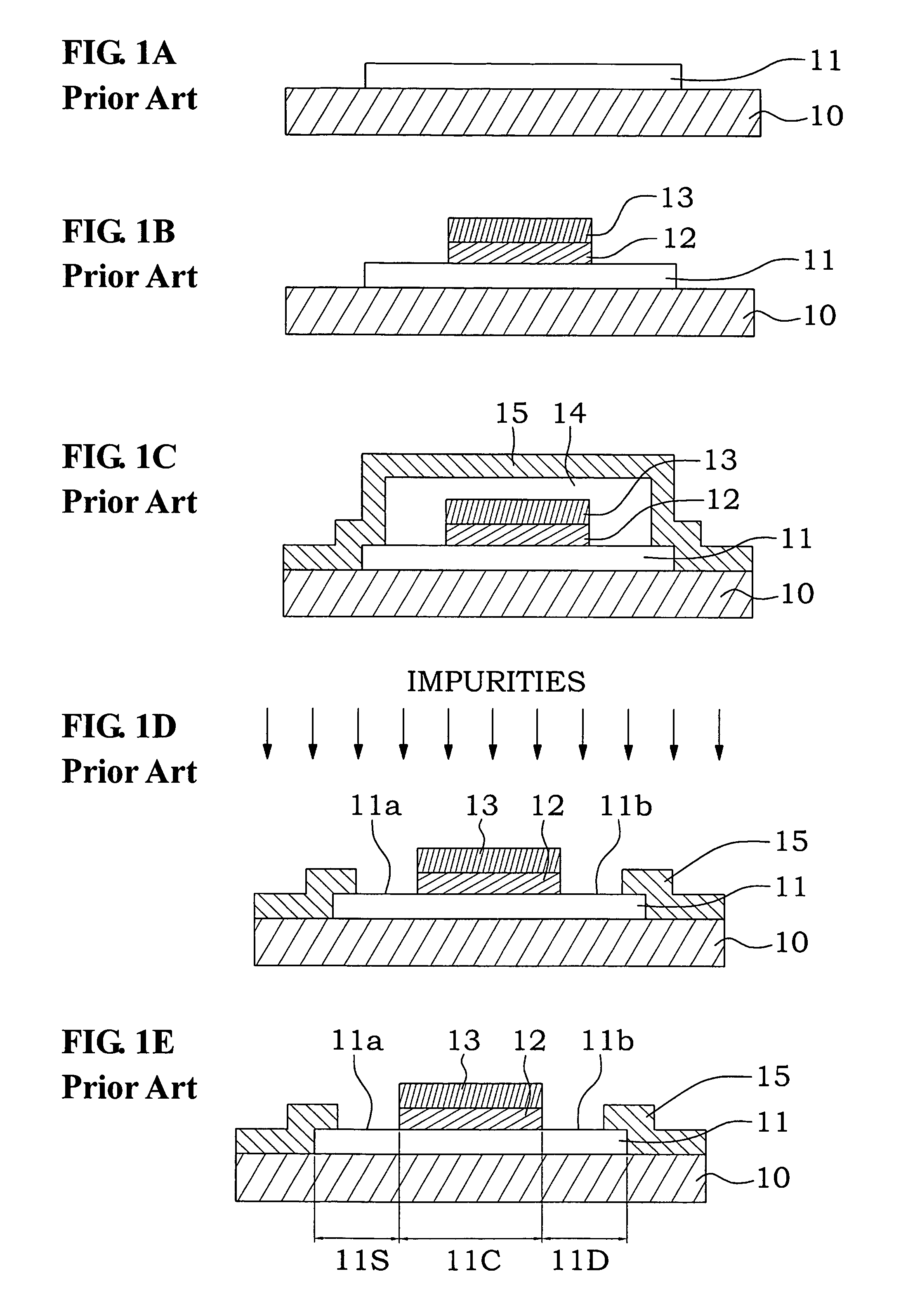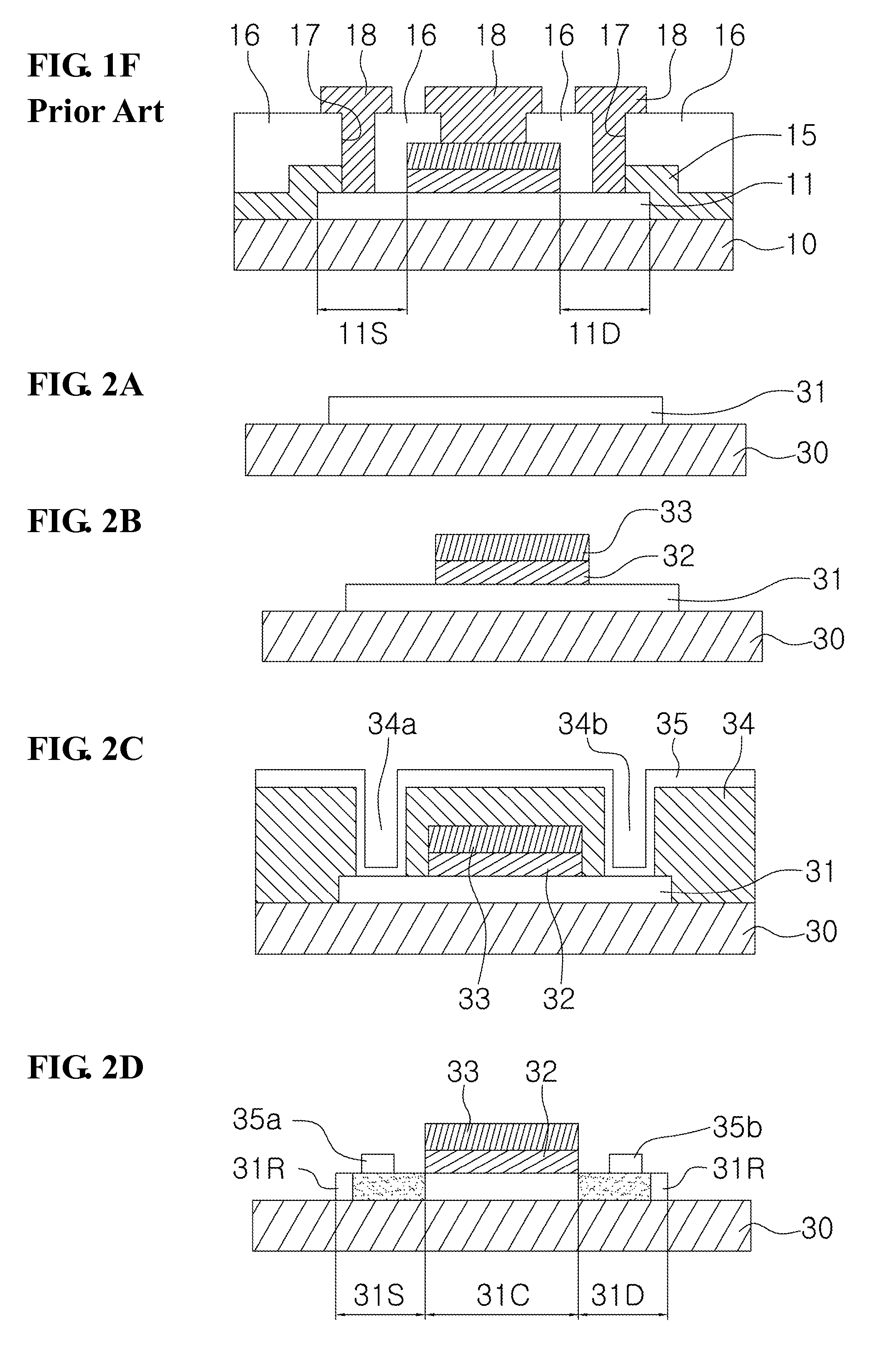Method of crystallizing amorphous semiconductor thin film and method of fabricating poly crystalline thin film transistor using the same
a technology of amorphous semiconductors and thin films, which is applied in the direction of crystal growth process, polycrystalline material growth, chemistry apparatus and processes, etc., can solve the problems of deteriorating an electrical feature of a device, long processing time, and long heat treatment time necessary for crystallization, etc., and achieves high speed, easy formation, and high speed
- Summary
- Abstract
- Description
- Claims
- Application Information
AI Technical Summary
Benefits of technology
Problems solved by technology
Method used
Image
Examples
first embodiment
[0073]As a result, it is possible to use seeds of MILC metal films using the contact method even at the time of fabrication of the N-type TFT in the present invention. Accordingly, in the present invention, a separate mask does not need to be fabricated in order to form seeds of the MILC metal films 35a and 35b, but a contact mask which is essentially fabricated in order to form a contact window with respect to the source and drain regions is used for fabricating a thin film transistor (TFT), to thereby form a photosensitive film pattern 34 having contact holes 34a and 34b with respect to the source and drain regions.
[0074]Further, in the case of the conventional heat treatment method, boron (B) such as B2H4, or phosphorus (P) such as PH3 are doped into portions where the source and drain regions of a semiconductor layer made of amorphous silicon, and then crystallization of the amorphous silicon and activation of the impurities are simultaneously accomplished at a one-time crystall...
second embodiment
[0081]Hereinbelow, a method of fabricating a thin film transistor using a MILC method according to the present invention will be described with reference to FIGS. 4A through 4G.
[0082]Referring to FIG. 4A, an amorphous silicon thin film is deposited on a transparent insulation substrate 40, through a CVD (Chemical Vapor Deposition) or sputtering method and then patterned using a mask (not shown) for forming a semiconductor layer, to thereby form a semiconductor layer 41.
[0083]Then, as shown in FIG. 4B, a photosensitive film pattern 42 having contact holes 42a and 42b with respect to a source region and a drain region is formed on the substrate 40 using a mask (not shown), and then a MILC metal film 43 is deposited on the entire surface of the substrate 40. As a result, the MILC metal film 43 contacts partially the source and drain regions via the contact holes 42a and 42b.
[0084]The MILC metal film 43 is deposited with a thickness of 10˜10,000 Å, preferably, 10˜200 Å, on the insulati...
third embodiment
[0098]Hereinbelow, a method of fabricating a thin film transistor using a MILC method according to the present invention will be described with reference to FIGS. 5A through 5F.
[0099]Referring to FIG. 5A, a photosensitive film is deposited on a transparent insulation substrate 50, and then patterned using a mask (not shown), to thereby form a photosensitive film pattern 51 in which first and second contact holes 51a and 51b for the source and drain reservation regions are disposed at a predetermined interval.
[0100]Then, a MILC metal film 52 is deposited on the entire surface of the substrate 40 where the photosensitive film pattern 51 has been formed. As a result, the MILC metal film 52 contacts partially the source and drain reservation regions via the contact holes 51a and 51b.
[0101]The MILC metal film 52 is deposited with a thickness of 10˜10,000 Å, preferably, 10˜200 Å, on the insulation substrate 40, by any one of sputtering, evaporation by heating, PECVD (Plasma Enhanced Chem...
PUM
| Property | Measurement | Unit |
|---|---|---|
| temperature | aaaaa | aaaaa |
| temperature | aaaaa | aaaaa |
| temperatures | aaaaa | aaaaa |
Abstract
Description
Claims
Application Information
 Login to View More
Login to View More - R&D
- Intellectual Property
- Life Sciences
- Materials
- Tech Scout
- Unparalleled Data Quality
- Higher Quality Content
- 60% Fewer Hallucinations
Browse by: Latest US Patents, China's latest patents, Technical Efficacy Thesaurus, Application Domain, Technology Topic, Popular Technical Reports.
© 2025 PatSnap. All rights reserved.Legal|Privacy policy|Modern Slavery Act Transparency Statement|Sitemap|About US| Contact US: help@patsnap.com



